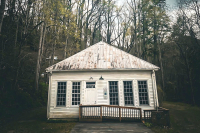Home for the summer: Birders seek out migrating birds in the mountains
 In a woodsy neighborhood up a winding mountain road from Franklin, late May is pretty quiet — at least from a human perspective. Many of the second-home owners who live there haven’t yet moved in for the summer, and with lots spanning as many as 40 acres, things are spread pretty far apart anyway.
In a woodsy neighborhood up a winding mountain road from Franklin, late May is pretty quiet — at least from a human perspective. Many of the second-home owners who live there haven’t yet moved in for the summer, and with lots spanning as many as 40 acres, things are spread pretty far apart anyway.
But the avian summer move-ins are there in force, and if you’re a bird, you’d probably say the forested neighborhood is anything but quiet. It’s full of tweets and chirps and chirrs, pretty sounds that actually mean things are a-stirring in the bird community.
“When I play my [bird call] tape, they say, ‘there’s someone getting in my area,’” explained Jim Shelton, in the midst of guiding a Franklin Bird Club walk through his neighborhood with his wife Ellen. “They’re coming to run you off.”
Just liked the stereotypical old man yelling for those dang kids to get off his yard, a sweet-sounding call is the equivalent of, “get away from my nest, you pesky humans!”
But those threats didn’t scare off the Franklin Bird Club.
“Everybody keep kinda quiet,” Shelton instructed as the group emerged from their four-car caravan. Don’t slam the doors, don’t yell — just watch, listen and maybe break out a bird call box.
Related Items
After a few moments of silence, things started happening. An ovenbird talked back to the call box right out of the gate, though keeping just deep enough into the woods to elude prying eyes. An Eastern wood-peewee struck a pose, and a blue-headed vireo flitted around the canopy. A veery — a rarer sight — came right to the edge of the road, showing his off ruddy colors to full effect.
But the brown creeper that the Sheltons had been hoping to show their birding buddies remained elusive, despite having made a long and fearless appearance there the day before. Some neighbors are just never home when you need them.
The mountain road up Walnut Creek isn’t the Franklin Bird Club’s usual haunt. Most often, their members can be found looking through binoculars on the Franklin Greenway. But the high elevations — the Sheltons’ home sits at about 4,300 feet compared to Franklin’s 2,100 — houses a set of residents not typically found in town. Like the neighborhood’s human residents, who mostly reside there during the summer months only, the bird community this time of year contains a large number of neotropical migrants. That means they spend their winters down in Central and South America, only coming north for the summer breeding season. When the nights start getting chilly again, they and their offspring head south.
“That’s a big deal if you think about it,” Shelton said. Migrating birds cover a lot of miles per inch of wingspan.
But once arrived, the birds settle comfortably into their summertime niches. Some, like the ovenbird and veery, flit around the forest floor and build nests on the ground. Others, like the red-eyed vireo, sing from treetops so high they’re a tough sighting for birders to log. Indigo buntings like to show off their flashy blue feathers in brushy edges between meadow and forest.
All these summertime arrivals, however, have to work it out with the full-time residents. Robins, juncos, chickadees, song sparrows — they all tough it out through the winter as well as the summer.
Their non-migratory habits might make them more common sightings, but the birders are quick to say that common sightings don’t equal boring sightings.
“I never get tired of seeing the same species over and over,” said Rita St. Clair, who represents the bird club on the Friends of the Greenway board.
Like the front-porch-sitting neighbor who gives you a wave day after day, North Carolina’s full-time species are comforting, familiar sights to birders well acquainted with the winged world. And those familiar sights offer countless variations on theme.
“You see something different every time,” said Karen Lawrence, who often leads bird club walks along the Franklin Greenway. “If you don’t see a different bird, at least you see a different behavior of that bird or you hear a different call or you learn the call better.”
But nothing compares with spotting the striking tropical colors of migrant birds through the leaves. Like those of the indigo bunting, blue body gleaming in the sun as it raises its head in song, perched amid a field of growing Christmas trees. Or the Canada warbler, black collar handsome against its golden head and chest.
“They’re so striking,” said Jean Honnicutt, one of the club’s founding members.
Striking, too, was the tally of birds spotted or heard in two hours on the mountain, 33 in all. Less than the 45 or 50 that might turn up during a typical outing to the greenway, sure, but the guest list on the mountain is a bit more exotic.
It’s a group of birds whose acquaintance Lawrence is glad to have made.
“I’m just glad to know they’re still out there,” she said.
Bringing the birds
People looking to turn their backyards into bird Meccas will get some help with a presentation 7 p.m. Monday, June 15, at the Macon County Public Library in Franklin.
Area birding expert Jim Shelton will discuss bird feeders, food sources, water features and bird-friendly plants, while Bill Messina of Spring Valley Nursery will talk about native plants that birds like.
A program of the Franklin Bird Club. 828.524.5234. www.franklinbirdclub.com
https://smokymountainnews.com/archives/item/15819-home-for-the-summer-birders-seek-out-migrating-birds-in-the-mountains#sigProId40e7d4a442
Meet the neighbors
Eastern wood-peewee
A resident of northern South America by winter and the eastern U.S. by summer, the wood-peewee is a sit-and-wait predator that hangs out in the trees when it’s not chasing after insects. It gets its name from its slurred call — pee-a-wee.
Veery
This small wood thrush sings its cascading song at dusk and dawn during its stay in the Appalachians. Wintering in South America, the veery eats insects and fruit, forage from the forest floor. But the bird can fly — a recent study showed the veery can cover up to 160 miles in a night and fly at altitudes above 2,000 feet.
Canada warbler
This colorful bird doesn’t linger long in the north. It’s one of the last warblers to arrive in the spring and one of the first to leave in the fall. It makes up for the short stay in good looks, boasting a bright yellow throat, chest and belly contrasting with a necklace of short black stripes.
Indigo bunting
This all-blue bird, sometimes nicknamed “blue canary,” spreads throughout eastern North America during late spring and summer, hanging out in fields and shrubby areas near forest cover. During migration from Central America, the indigo bunting travels at night, using the stars for guidance.
Dark-eyed junco
In the high elevations of the Appalachian Mountains, juncos stay put year-round. These little sparrows are one of the most abundant birds in North America, with a recent estimate putting their population at 630 million.
Chipping sparrow
Spreading throughout the United States in the summer, this ruddy-headed songbird hops through grasses to forage for seeds. They raise broods of two to seven eggs in nests so thin that light can be seen through them.
Source: The Cornell Lab of Ornithology and Audubon Field Guide.










